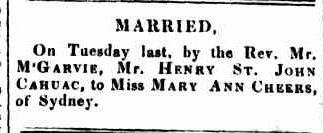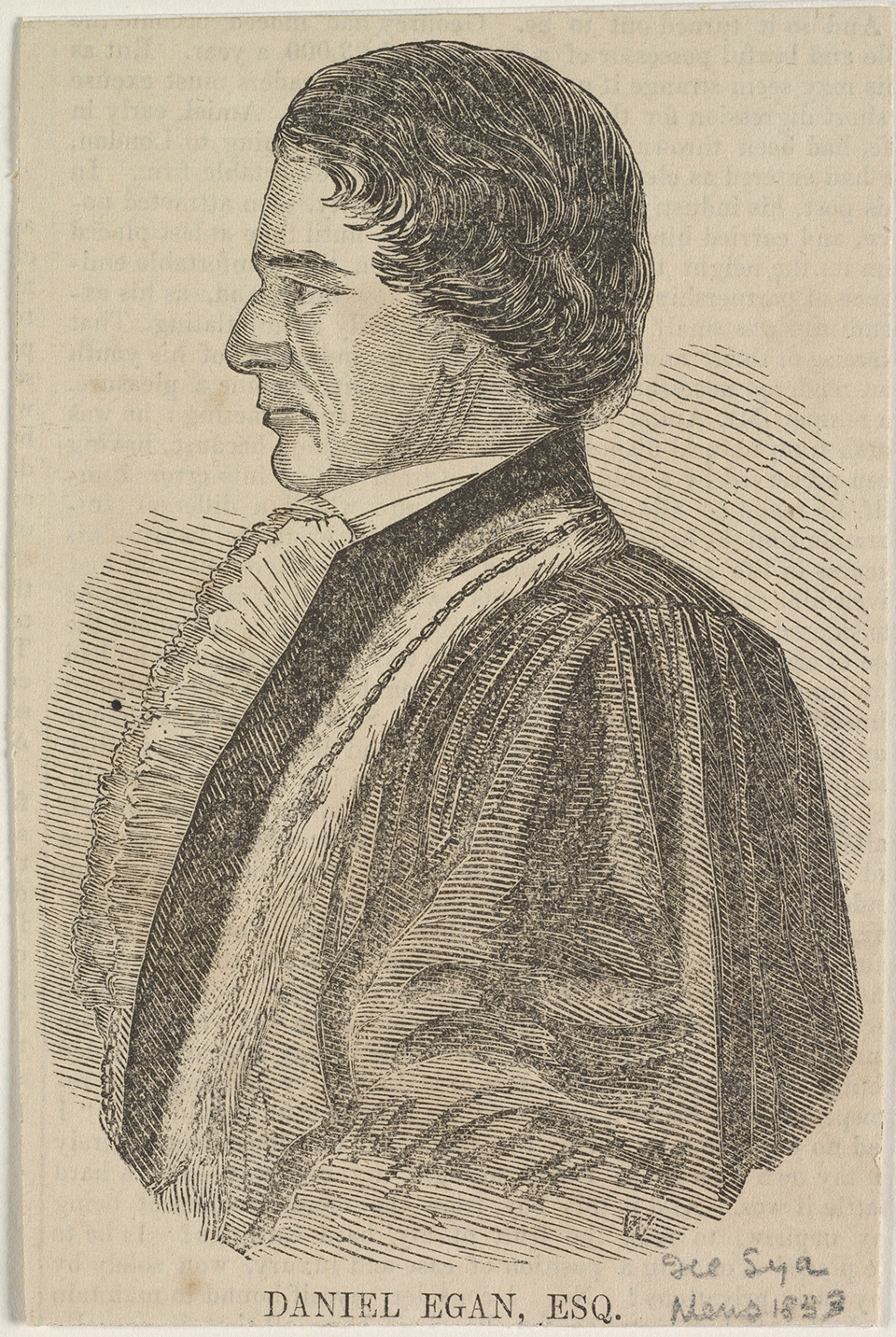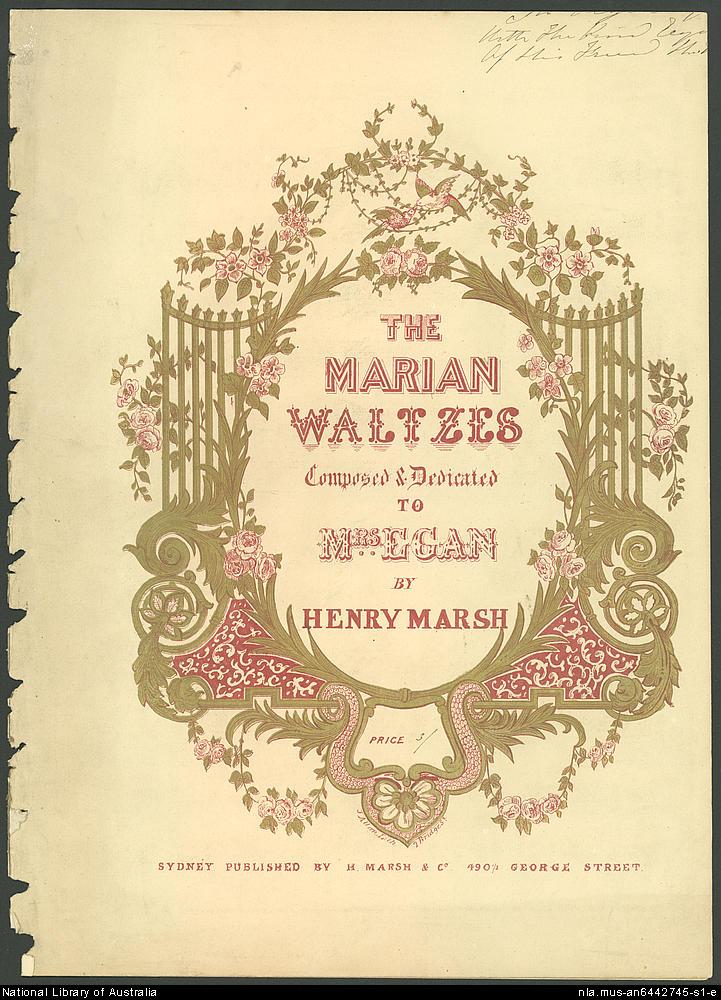The Dictionary of Sydney was archived in 2021.
Egan, Marian
Citation
Persistent URL for this entry
To cite this entry in text
To cite this entry in a Wikipedia footnote citation
To cite this entry as a Wikipedia External link
Egan, Marian
Mary Anne Cheers was born in Sydney on 8 March 1818, second child of Jane and Richard Cheers. Jane Anne Smith had been transported for theft in 1814 on the Wanstead and married Richard Cheers on 15 October 1815, becoming his fourth wife. She bore him four children before her death in March 1823 of 'a very sudden attack of indisposition'.[1]
Marian's father, Richard Cheers, was not a stranger to marine disaster. He was one of 25 convicts selected for their skills in husbandry, much needed by the new colony, to be sent in 1789 on the Guardian. The ship also bore provisions and materials which would help save the colony from famine. When the ship was almost wrecked near Table Bay, Cheers was one of 20 convicts who remained aboard and helped bring it to port. Transferred to the Surprize, he arrived in the colony in June, 1790.
Richard Cheers, Daniel Cubitt and their companions in the good work of saving the Guardian from total wreck, landed as absolutely free men. Lieutenant Riou's letter to Governor Phillip secured them a favourable reception at the Sydney Settlement and the King's pardon followed as soon as long voyages would permit. [2]
Cheers claimed to be the first butcher in the colony and to have practised this trade since his arrival. [3] Given land grants in Sydney, [4] he set up a butchery which prospered on the grant extending from George and Hunter streets to the Tank Stream. On the other grant, on the southern corner of George and Essex streets, he built and managed the Black Bull Inn. He was also granted land for farms at Ryde and Manly.
Marian's first marriage
[media]On 29 July 1834 Marian Cheers married Henry St John Cahuac. Henry's father John, a London bookseller, was transported to Van Diemen's Land for 'buying books, knowing them to be stolen' and 'for publishing blasphemous libel'. [5] On arrival he successfully applied to move to Sydney and to have his family brought out at government expense. His wife Mary and children Henry and Sophia arrived in Sydney in 1825. Henry is listed in the 1828 Muster as clerk to the Principal Superintendant of Convicts at Darling Harbour and at the time of his marriage his occupation was farmer. In 1835 Marian gave birth to a son 'which survived only a few hours'. [6] Later two children were born to them: Henry William (1837) and Gertrude Evans (1839). From 1837 to 1841 Cahuac managed farms in the Kempsey area where they settled. The Commissioner for Lands described their property in January 1841 as having 'a good slab house, huts, well-fenced paddocks, a piggery and a stockyard with 30 acres of maize under cultivation and good soil watered by the McLeay River and creeks.' Sadly, in 1841 Henry was killed in a fall from a horse at their property Euroka. A very poignant account of the incident is given by a relative in his memoirs:
A fatal accident happened to poor Mr K [7] about this time. One of the men arrived at Yarrabandini late in the afternoon with the sad information. My Mother & Father started away at once by boat for Euroka – 8 miles. Mr K left home the day previous riding a beautiful filly which he had the loan of from our stud. Mrs K was rather anxious at his not returning that afternoon. The following day the filly was seen outside the fence with the saddle on. Shortly after his body was found where the poor fellow lay all night. The filly it was surmised fell & rolled over on him. Death must have been instantaneous for there was no indication of struggling. Mrs K & her two children returned with my parents after the funeral & remained with us several weeks. She then sold her Macleay Interest to my Father & went to Sydney where she had some City property which afforded her a comfortable living. Many years after this she and her two children took a trip to England & the Continent & in returning to Sydney perished in the disastrous wreck of the 'Dunbar.' [8]
In the following year 1842 her sister Elizabeth's next child was born and named George St John Evans. Her brother James' next child, also born in 1842, was named Frederick Henry Cheers. The second names of these babies would appear to be tributes to the memory of their parents' brother-in-law. Elizabeth and John took over Euroka and farmed it for several years. Marian returned with her two small children to Sydney where she owned property.
Marian's second marriage
[media]On 17 July 1843 she married Daniel Egan at St Mary's Cathedral and also at the Anglican church of St James. This 'repeated' marriage might suggest that she, Anglican, and he, Catholic, amicably retained their respective religions and an intention to continue to raise the children of their first marriages in their respective faiths. [9] Or it may indicate an astute attempt to increase the politician's voter base. The marriage was proudly announced on the Sydney Morning Herald of 18 July 1843 and recorded in the church registers of both St Mary's and St James.
Daniel was the son of former convict Brian Egan who arrived in 1797 on the Britannia and was at different times a farm labourer and boat owner. His mother Mary Brien (Bryant), having arrived to join her husband, was a Rocks householder and 'probably took in lodgers and kept a drinking house'. [10] Daniel Egan was a shipbuilder and merchant, who became a member of the first Sydney Council of 1842, representing Gipps Ward, and was a councillor until he was elected Mayor in 1853. He was also a member of the Legislative Council from 1854 to 1870.
The wreck of the Dunbar
Marian Egan and her two children, Henry and Gertrude Cahuac, left for London on 24 December 1855 on the Vimeira. Her intention was 'to afford her children an opportunity to see society, in its more settled and antient forms'. [11]
We know that in June 1856 she was lodging at No 9 Craven St, Strand, where she was visited by a friend Mrs Campbell, who had also been on the Vimeira voyage with her six children. Mrs Campbell had suffered a miscarriage during the trip and also begun an affair with a Mr Garstin which she refused to end. Her husband visited her at Mrs Egan's lodgings to try to persuade her to return. But the matter ended in divorce. [12]
Marian and her children returned to Sydney on the Dunbar in 1857. As history records, on 20 August 1857 the Dunbar was wrecked while attempting to enter Sydney Harbour on a tempestuous night and tragically all aboard, except one, were lost. In their desperation Daniel Egan and Mr Waller, no doubt a relative of the Waller family all eight of whom were lost, chartered the Black Swan to conduct their own search without success. [13] Grief-stricken, Daniel Egan arranged for three stained glass windows to be installed in St Mary's Cathedral in honour of his wife and the stepchildren he had raised from an early age.
The windows were made by John Hardman & Co of Birmingham, and installed in the cathedral in 1860. Two of the windows were recovered after the cathedral was destroyed by fire in 1865 – the sidelights, which depicted St Henry of Germany and St Gertrude, patron saint of travellers. Text on the windows read:
Pray for the souls of Mariann Egan and her two children Henry and Gertrude Cahnac [sic]
Drowned in the wreck of the Dunbar on the South Head of Port Jackson March (sic) 20th 1857
The salvaged windows were preserved and later installed in the chapel of St Benedict's Monastery, Arcadia.
At a 150th anniversary commemorative service of the Dunbar tragedy in 2007, a painting of Marian Egan and her two children, begun before they left England in 1857, was shown for the first time in public. It is owned by Dr Christian Garland, a fifth-generation descendant of Marian's sister, Elizabeth Evans.
A woman of property
Marian, her sister Elizabeth and brothers James and William inherited their father's property on the northern corner of George and Hunter streets, the Land Grant of 1806 where he had established his successful butchery. She and Elizabeth managed the section of William and Adelaide place from George Street to Little Hunter Street. In 1853, no 3 Hunter Street was the subject of a Supreme Court case. Clothing merchants J and E Leathem had been tenants since 1850, having leased it from Marian, who was acting as an agent collecting rent for John and Elizabeth Evans, her sister and brother-in-law. Leathem had signed a written agreement with John Evans to vacate the premises on a certain date but would not do so. The family therefore sought and obtained an ejectment order to recover possession of No 3. [14]
Marian was remembered after her death as 'a lady of eminent charity and piety', who was 'recollected in her circle for her maternal care of Bishop Davis', Catholic Bishop of Maitland 1847–54, 'during his fatal sickness'. [15]
In 1849 she supported her son Henry's candidature as a postulant with the Benedictines. [16] She collected subscriptions from a large number of people for a Free Hospital and residence for the Sisters of Charity. [17] These efforts came to fruition in December 1857 when it was reported that the villa Tarmons at Potts Point had been purchased for the Sisters and St Vincent's Free Hospital was about to begin its charitable work.
In 1853 she contributed to the founding of the 'noblest of public charities', the Destitute Children's Society, and at the laying of the foundation stone of the Children's Asylum, Randwick, in 1856 her name was included in a parchment listing supporters. [18]
She also enjoyed a busy social life. At the Mayoral Ball of 1844 she wore unspecified fancy dress while her husband dressed as a Royal Arch Mason and her stepdaughter Josephina wore a costume of the Louis XIV era.
At the Ball of 1847 she dressed as Arline, while her husband wore 'civic costume', and Josephina dressed as Kathleen O'More. Arline was the heroine of Balfe's The Bohemian Girl, a popular new opera performed in Sydney theatres at the time: her character was a noblewoman raised as a gypsy, her celebrated aria being I Dreamt I Dwelt in Marble Halls. So the costume would presumably have been that of a gypsy.
[media]In Egan's mayoral year, 1853, The Marian Waltzes were composed for the Ball and 'dedicated to Mrs Egan' by a Sydney musician and music vendor, Henry Marsh. [19]
Anne Hale Chapman, a relative, recalled 'delightful parties' given at the Egan home in Hunter Street around 1850 where she met, among others, the widower Governor FitzRoy and his son George. And:
Mrs Egan took me to a great Race Ball, given by Mr & Mrs R. Fitzgerald of Windsor. We stayed there a fortnight and went to the races in the open Carriage and cut a great dash. Mrs Fitzgerald, Mrs Egan, Miss Egan [Marian's stepdaughter], Hariett Walsh [Marian's niece] and myself – lots of young Gentlemen came to the Carriage, the Fitzroys, Hassells, Sam Terry, James Martin, Pantons (3). Then the Ball, and Champagne suppers every night for the week; then we returned to Sydney after a “Pic Nic” down part of the Hawkesbury River. How we did enjoy ourselves!! [20]
Marian seems to have enjoyed some popularity and prominence, as after her death a portrait 'painted in crayons by Mr Dalton from a daguerreotype' was displayed at his studio, 243 George Street. [21]
References
Charles H Bertie, The Early History of the Sydney Municipal Council, Town Hall Sydney, 1911
Frederick W Chapman, 'Yarrabandini Early Days on the Macleay River 1836–1908', State Library of NSW, Mitchell Library manuscript, ML MSS 1570
Christian Garland, 'The Egans', Pioneer, September 2007
Kieran Hosty, Dunbar 1857: Disaster on our doorstep, Australian National Maritime Museum, Sydney, 2008
Jeffrey Mellefont, 'Faces from the Dunbar disaster', Signals, no 82, March–May 2008
Marie H Neil, Valley of the Macleay, Wentworth Books, Sydney, 1972
Assessment Books 1845–1950, City of Sydney Archives
Clay Nothling, The Cheers Family Tree Book, 2009, Society of Australian Genealogists Library
Notes
[1] Sydney Gazette, 27 March 1823 p 3
[2] 'Old Sydney No 276', The Truth Newspaper, 2 February 1913
[3] Colonial Secretary Correspondence, State Records NSW, AO Fiche 3002 4/1821 No 59
[4] Grants Nos 9 &19, James Meehan, Plan of the Town of Sydney, 1807
[5] Conduct Registers of Male Convicts 1803–1830, Archives Office of Tasmania, CON 31/1/6 No 626
[6] The Australian, 25 December 1835
[7] Mr K is Mr Cahuac. This derives from an erroneous but phonetic spelling (Kawack) in some handwritten documents
[8] FW Chapman, 'Yarrrabandini: Early Days on the Macleay River 1836–1909', State Library of NSW, Mitchell Library MSS 1570, pp 35–36, transcribed by A Lemercier. Chapman's father William Henry Chapman (1801–1857) was apprenticed with Daniel Egan at the Government Dockyard and became a successful shipbuilder and merchant with a wharf and business at Millers Point. Around 1840 he settled with his wife Ann and family at Yarrabandini, his property on the Macleay, where his Superintendent was Marian's brother James Cheers
[9] Daniel Egan's first marriage to Mary Ann Piper produced three children – Josephina (b 1826), John Piper (b 1827) and Hugh Piper (b 1829). Perhaps all five children were present at the marriage of 1843
[10] Grace Karskens, The Rocks: Life in Early Sydney, Melbourne University Press, Melbourne, 1997, p 92
[11] 'Narrative of the Wreck of the Dunbar', Sydney Morning Herald, 10 September 1857 p 5
[12] 'The Divorce Case of Campbell v Campbell', Bell's Life and Sporting Review, 22 August 1856
[13] Empire, 31 August 1857
[14] 'Doe Dem. Chapman and others v Leathem', Sydney Morning Herald, 22 September 1853, p 3, 10 November 1853, p 2, 22 October 1853, p 4, 1 December 1853, p 2; Empire 22 October 1853, p 4, 11 November 1853, p 2
[15] 'Narrative of the Wreck of the Dunbar', Sydney Morning Herald, 10 September 1857 p 5
[16] Benedictine Journals 1843–46, State Library of NSW, Mitchell Library, ML MAV/FM4/4251
[17] Empire, 8 February 1855
[18] Empire, 9 May 1856
[19] Sydney Morning Herald, 20 August 1853
[20] Anne Hale Chapman, 'Reminiscences of Anne Hale Chapman 1835–1903' (written 1894–1906), State Library of NSW, Mitchell Library, MSS 2837, pp 55/53
[21] Sydney Morning Herald, 8 December 1857




